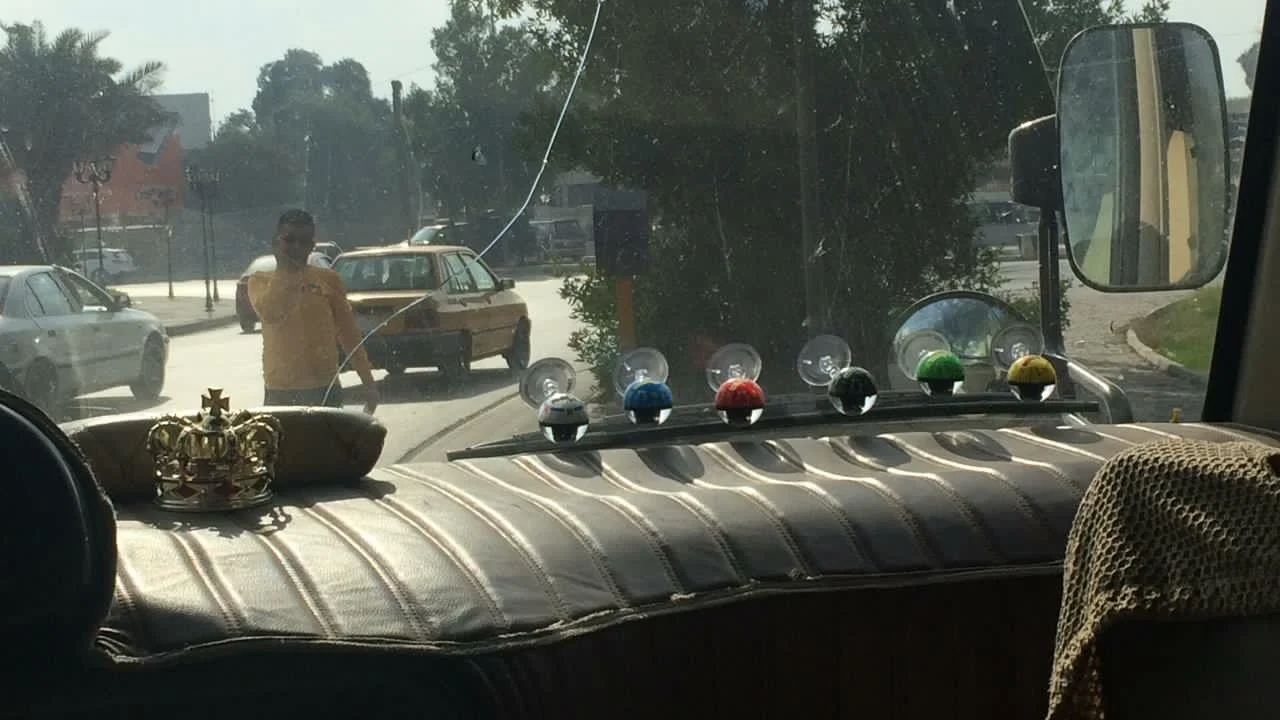Travelling around Baghdad by local bus
You may find that taxi apps such as Careem or Baly are already good value, but the buses that transport locals around Baghdad are really, really cheap. They are easier to use if you have some Arabic, a local to advise or perhaps even accompany you on your first trip, but a sense of adventure, a decent sense of direction and/or a map app can also help a bus mission.
Baghdad’s buses are all unmarked but most can be differentiated by appearance and location, although this takes a little practice to perfect.
Let’s take a straightforward route from Tahrir Square (where you might have been sightseeing) to Karada Dakhil (Inner Karada Street) - where you might wish to take coffee or supper - which costs a mere IQD500 ($0.38). It is easiest to pick up the bus on Sa’adoun street, close to Tahrir Square, facing towards Karada. There are two types of minibus that ply this route. The one you don’t want is the smaller, rounder minibus, as that goes to Karada Kharage (Outer Karada Street). The ones you do want are the larger squarer ones, called Coaster (but locally pronounced “Costa”), which are either all white, white with a pale blue panel across the bonnet or white with a black panel across the bonnet.
You can hail the bus literally anywhere, even if it has already stopped a few metres further up the street from you, by holding out your arm. The folding door (opened by the driver) will often already be open. You climb aboard, maybe say a general “Salam alaikum" (السلام عليكم - literally “peace be upon you” but widely used as a general greeting) or "Marhaban" (مرحبا - hello/welcome), and take a seat.
The seat configuration inside this particular bus is double seats on one side and single seats on the other. You can also sit beside the driver but that involves a bit of a clamber.
Although there are no restrictions regarding where you sit, if you need to sit next to someone, it’s more culturally appropriate if you are a man to sit beside another man and, if you are a woman, to choose a seat beside another woman. If the bus is busy, there may be little choice. If it’s very busy, there are fold-down extra seats in the central aisle.
If there’s absolutely no room on the bus, it won’t stop for you but, don’t worry, another will be along shortly.
Once seated, you promptly pass the smallest change you have around the IQD500 fare up towards the driver. You should ensure you have sufficient small notes (IQD250/500/1,000/5,000) before boarding the bus as change is limited. If you’re seated near the front you can hand your fare to the driver directly, otherwise you hand it to the person in front of you who will pass it up. If you are owed change, this will be handed back down through the bus to you.
We love these buses. They have a great vibe, sometimes brilliant decoration and occasionally music playing, and are just very real and close to the ordinary people of Baghdad and their way of life. The passengers are often an eclectic mix - students, middle-aged men in suits, housewives with children, grandmothers with carrier-bags of vegetables. Sometimes the buses are quiet but, as Iraqis are very sociable, there will often be chatter.
If you’re worried it’s the wrong bus, you could ask a general: “Karada Dakhil?” when you board and wait for affirmation, or a negative followed by a stream of Iraqi Arabic telling you which bus you actually need, which you may not understand but may be accompanied by helpful gestures.
We often prefer to stay on the bus until we’ve just passed our destination (to be sure) and then walk back to it, as it’s really annoying to alight way too early. To get the bus to stop, literally anywhere you fancy, you call out “Na’azle” (نازل - coming down/getting off). When the bus stops, you head towards the door and maybe say “Ma'a-salama” (مع السلامة - goodbye, or literally: with peace/safely) or “shukran” (شكراً - thank you) as you descend into the street. The slightly more formal Iraqi farewell of “Fi-aman-Allah” (في أمان الله - in God’s protection) can also be used.
Across Baghdad, bus fares are usually fixed, regardless of where you are going, and although not all routes are only IQD500, they are always very cheap. Occasionally a bus may abandon its journey early on in the route for no apparent reason and, if this happens, the driver will give you back your fare and you just hop out and wait for another one.
Bus services in the capital run with great frequency and usually with decent reliability during the day and into the night. Different minibuses serve all different areas of Baghdad but, as a foreigner, it can be pretty tricky to work out which one - or two, if you’re staying far out and feeling intrepid, or on a really tight budget - you need. So, if you don’t have any Arabic, you might prefer to consult an English-speaking Iraqi or perhaps hotel staff to advise before you set out. We generally find Iraqis extremely helpful and sometimes they are charmed when a foreigner wants to use public transport (perhaps partly because there is an assumption that all westerners are affluent).
If your first effort to take a bus doesn’t work out as expected and you end up somewhere unplanned and unknown, you can still always order a Careem or flag down an on-street yellow taxi to reach your destination.
Once you’ve nailed it, these buses are not only very cheap but interesting and authentic, and can add a fun adventure to traversing the capital.
